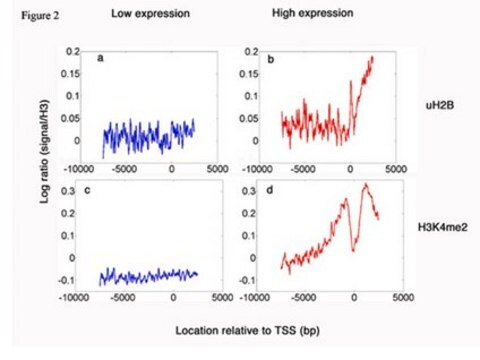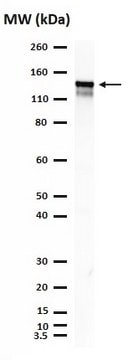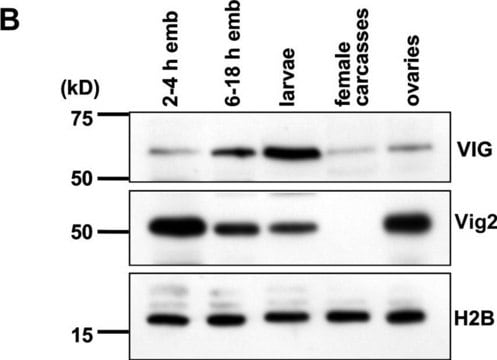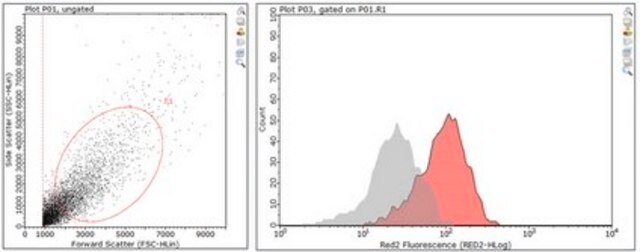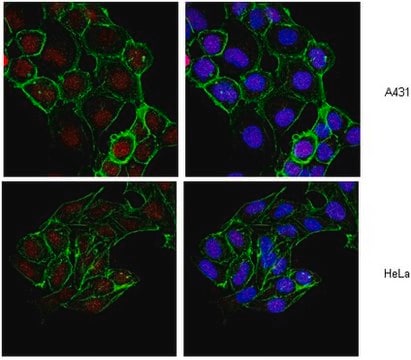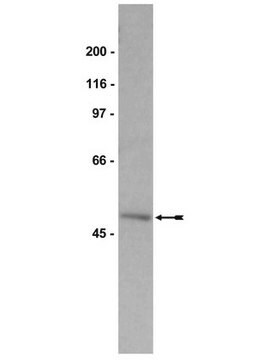17-650
ChIPAb+ Ubiquityl-Histone H2B - ChIP Validated Antibody and Primer Set
clone 56, from mouse, purified by using protein G
Sinonimo/i:
H2BUb, Histone H2B (ubiquityl), H2B histone family, member L, H2B.1 A, histone 1, H2bc, histone cluster 1, H2bc
About This Item
Prodotti consigliati
Origine biologica
mouse
Livello qualitativo
Clone
56, monoclonal
Purificato mediante
using protein G
Reattività contro le specie
mouse, rat, vertebrates, human, plant
Produttore/marchio commerciale
ChIPAb+
Upstate®
tecniche
ChIP: suitable
immunofluorescence: suitable
immunoprecipitation (IP): suitable
western blot: suitable
Isotipo
IgG2aκ
N° accesso NCBI
N° accesso UniProt
Condizioni di spedizione
dry ice
Descrizione generale
The ChIPAb+ Ubiquityl-Histone H2B, (clone 56) set includes the Ubiquityl-Histone H2B, (clone 56) antibody, a negative control antibody (purified Mouse IgG), and qPCR primers which amplify a 213 bp region within the coding region of the human GAPDH gene.
The ubiquityl-Histone H2B and negative control antibodies are supplied in a scalable "per ChIP" reaction size and can be used to functionally validate the precipitation of Ubiquityl-Histone H2B associated chromatin.
Specificità
Immunogeno
Applicazioni
Sonicated chromatin prepared from HeLa S3 cells (1 X 106 cell equivalents per IP) was subjected to chromatin immunoprecipitation using 1 μg of either a normal mouse IgG or Anti-Ubiquityl-Histone H2B antibody and the Magna ChIP G Kit (Cat. # 17-611).
Successful immunoprecipitation of ubiquityl-Histone H2B associated DNA fragments was verified by qPCR using GAPDH promoter (negative) and GAPDH coding (positive) Primers (Please see figures). Data is presented as percent input of each IP sample relative to input chromatin for each amplicon and ChIP sample as indicated.
Please refer to the EZ-Magna G ChIP (Cat. # 17-409) or EZ-ChIP (Cat. # 17-371) protocol for experimental details.
Western Blot Analysis:
HeLa cell lysate was resolved by electrophoresis, transferred to PVDF and probed with anti-Ubiquityl-histone H2B at a dilution of 1:4000 (Please see figures).
Epigenetics & Nuclear Function
Chromatin Biology
Histones
Confezionamento
Qualità
Sonicated chromatin prepared from HeLa S3 cells (1X 106 cell equivalents per IP) were subjected to chromatin immuno-precipitation using 1 µg of either a normal mouse IgG or Anti-ubiquityl-Histone H2B, clone 56 antibody and the Magna ChIP® G Kit (Cat. # 17-611). Successful immunoprecipitation of ubiquityl-Histone H2B-associated DNA fragments was verified by qPCR using Control Primers.
Please refer to the EZ-Magna ChIP G (Cat. # 17-409) or EZ-ChIP (Cat. # 17-371) protocol for experimental details.
Descrizione del bersaglio
Stato fisico
Normal Mouse IgG. One vial containing 25 μg purified mouse IgG in 25 μL storage buffer containing 0.1% sodium azide. Store at -20°C.
ChIP Primers GAPDH Coding Region. One vial containing 75 μL of 5 μM of each primer specific for the coding region of human GAPDH. Store at -20°C.
FOR: GGC TCC CAC CTT TCT CAT CC
REV: GGC CAT CCA CAG TCT TCT GG
Stoccaggio e stabilità
Risultati analitici
Includes negative control mouse IgG antibody and primers specific for human GAPDH coding region.
Note legali
Esclusione di responsabilità
Codice della classe di stoccaggio
10 - Combustible liquids
Certificati d'analisi (COA)
Cerca il Certificati d'analisi (COA) digitando il numero di lotto/batch corrispondente. I numeri di lotto o di batch sono stampati sull'etichetta dei prodotti dopo la parola ‘Lotto’ o ‘Batch’.
Possiedi già questo prodotto?
I documenti relativi ai prodotti acquistati recentemente sono disponibili nell’Archivio dei documenti.
Il team dei nostri ricercatori vanta grande esperienza in tutte le aree della ricerca quali Life Science, scienza dei materiali, sintesi chimica, cromatografia, discipline analitiche, ecc..
Contatta l'Assistenza Tecnica.